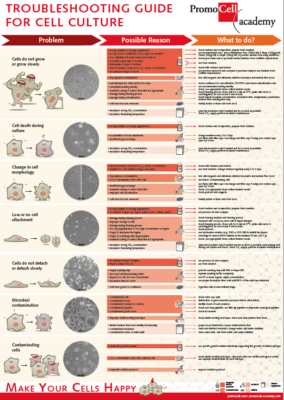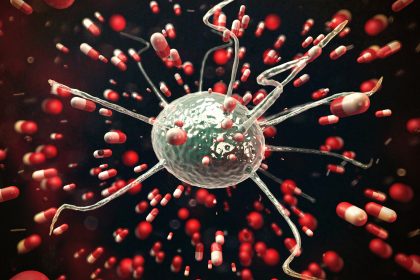“Why was the expression of my protein so low last time? Hm, I don’t really have new results for the next progress report. Hey, I wonder what’s for lunch at the cafeteria today!” You know these kinds of thoughts, don’t you? Tim does, too. The biologist’s mind is wandering far and wide, although the cells he is treating need his undivided attention. Especially since the primary cells he has been working on for the last couple of days are behaving strangely. They are growing slowly, and somehow don’t look quite ok – but surely, it could be worse, right?

“Tim is the archetype of the dozens of scientists I talk to daily,” says PromoCell expert Dr. François Pujol. Their behavior is often the same. Having spent a few years in the lab, researchers such as Tim have developed confidence while working in the hood. Disinfect, wipe, done! But with routine comes carelessness, and so mistakes are just waiting around the corner. Let’s take Tim as an example, and go back to the basics. Along with the science, lab work is a craft, and there are some general rules you should keep in mind while working with cell cultures. Sadly, Tim seems to have forgotten some of them.
Today, Tim’s new order of primary mesenchymal stem cells has just arrived at his lab. Instead of opening the parcel, unpacking the vials, and immediately beginning to thaw the cells in the water bath as he would normally do, he decides to call the customer support at PromoCell for advice. “Starting a culture is the most crucial step – and here is where most mistakes happen,” says Dr. Pujol, who works as Scientific Support Specialist. “Before you proceed, sit down and read the instructions that we send with every vial. The protocols aren’t there for the fun of it – we provide them because they work. Your part is to familiarize yourself with what you are going to do before you do it.”
“You don’t want your primary cells to be grumpy.”
Dr. Pujol reveals the most important secret of all to Tim: “Preparation! Make sure you have everything you need ready. For example, that your hood is equipped with sterile pipettes and tips, and that the specific medium has been pre-warmed in the incubator. Speaking of warm: Have you checked the temperature of your water bath lately with a mercury or alcohol thermometer? Or do you trust the digital display blindly?” As it turns out, this is a common source of problems that result in fatal consequences. If the temperature is higher than 37°C, your cells will suffer. If it’s too low, thawing takes too long – and the cells are irreversibly damaged.
Only with good preparation can Tim follow Dr. Pujol’s second piece of advice: “Timing! You have just five minutes to take the cells out of the dry ice, thaw them, plate them out, and finally transfer them into the incubator – this isn’t a lot of time. Especially since you should hold them – no, not using a floater – in the water bath for two minutes.” So you need to be quick. At the same time, you want to be gentle to your cells and “not pipette up and down like a maniac.” The cell specialist uses a very lively comparison: “Primary cells are like human beings. If you try to wake them up by touching them softly, they will get up eventually – but they will be late for work. On the other hand, if you shake them vigorously, they will wake up quickly – and will be really grumpy all day long.” A good balance between speed and gentleness is what scientists like Tim need to achieve.
The density of happiness
After heeding the expert’s advice, Tim’s primary cells proliferate nicely. As they show a consistent doubling time, he lets them grow to a certain confluence level. “When the density is about 70-90 percent, it’s an ideal moment to subculture your cells. Cells need friends around to be happy – not too few, and not too many. Again, it’s the same as with humans – most of us don’t feel comfortable in crowded places. Also, in contrast to most classical cell lines (and human beings), some primary cell types terminally differentiate when they have reached complete confluence,” says Dr. Pujol.
Picking the right density in your flask can lead to a win-win situation: You can have a high number of cells, and at the same time, an efficient treatment with trypsin. The protease mix needs access from underneath the cells so it is able to detach them by digesting the cell-cell and cell-surface binding proteins. “Lab work is a lot like cooking. Imagine you want to melt a big piece of butter or chocolate. You have two options: 1) putting the block in the pot and waiting – for a long time. This is like having a 100% confluency in the flask. Or 2) chopping the block into smaller pieces, so the mass melts faster. This corresponds to a confluency of 70-90%.” When the enzymatic digestion is allowed to take place for too long, the cells will be irreparably damaged.

Tim is grateful for the tips on starting cell cultures, and now wants to be on the safe side. He plans to freeze some cells for use in further experiments, and as reference. Before Tim begins, Dr. Pujol shares some words of wisdom. “Freezing is always stressful for cells, and will shorten their life span. No matter what you do, the cells will remember the number of passages they had before freezing. You can’t extend their life – there is no magic. If you can’t avoid freezing, you should at least try doing it as early as possible, and with the lowest passage number possible.” A lot of labs have their own protocols for freezing cells, which generally require using medium that includes high level of serum and DMSO. “Ironically, they work perfectly as a cryoprotective solution,” says Dr. Pujol. “But be aware that serum contains a lot of unknown factors. Because primary cells are highly responsive to stimulation, serum will affect them by triggering signal pathways not under your control, and even a short exposition is sufficient. Also, the high DMSO concentration will affect the cells. To compensate this, you would need to wash the cells by centrifuging them before starting the culture – and this, again, is stressful for your cells.”
Tim decides to use PromoCell freezing medium, which is serum-free and which has a very low DMSO concentration, and he plans to consciously follow the protocol provided. When freezing is done properly, it ensures that the vials are frozen at -1°C per minute – and that Tim will have living cells when he thaws them.
The secret of successful cell culturing
“More than 90 percent of the customers who reach out for our service and have concerns about their primary cells is because they have handled them incorrectly,” says Dr. Pujol. “However, if you do proper documentation, followed by stringent troubleshooting, together we can most likely find the source of problems – and you can avoid them in the future by learning the right technique.”
To underline the importance of proper cell culturing, leading authorities such as the British Journal of Cancer have published “Guidelines for the use of cell lines in biomedical research”.
For scientists like Tim, who have just started working with mesenchymal stem cells (MSCs) flawless handling is especially important. Like most primary cells, MSCs are known to be extremely sensitive to changes in their environment. Therefore, journals increasingly ask for authentication of the MSCs used before publishing results. In addition to saving time and money, and preventing frustration, this is another reason why you should seek proper handling information before starting.
No matter what your research interest is – or what your lunch preferences are – you need to keep just one simple rule in mind, says Dr. Pujol. “If you are nice to your cells, they will be nice in return.”



